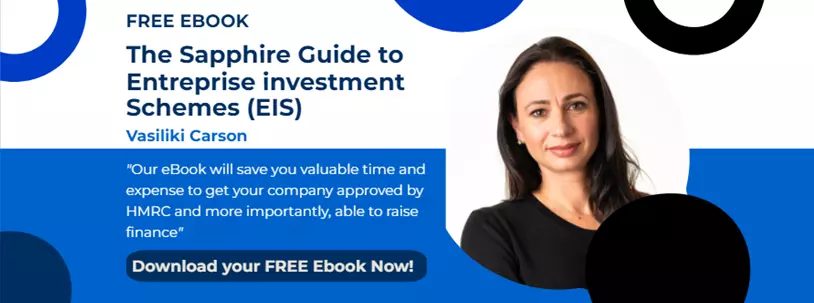 The Seed Enterprise Investment Scheme (“SEIS”) and Enterprise Investment Scheme (“EIS”) are tax-efficient schemes introduced by the government to reduce investors capital at risk when investing in early-stage start-up companies. One of the main questions we often hear is “What tax reliefs will I receive if I invest in an EIS company or fund?” This blog will attempt explain the basic tax reliefs offered to qualified EIS investors who invest in an EIS company or fund, which include:
The Seed Enterprise Investment Scheme (“SEIS”) and Enterprise Investment Scheme (“EIS”) are tax-efficient schemes introduced by the government to reduce investors capital at risk when investing in early-stage start-up companies. One of the main questions we often hear is “What tax reliefs will I receive if I invest in an EIS company or fund?” This blog will attempt explain the basic tax reliefs offered to qualified EIS investors who invest in an EIS company or fund, which include:
-
Income Tax Relief
-
Capital Gains Tax Deferral Relief
-
Inheritance Tax Relief
-
Capital Gains Tax Exemption
-
Loss Relief
It is noted that the investment in the company shares must remain qualifying throughout the three-year minimum holding period for investors to claim and keep their EIS reliefs.
Income Tax Relief
Investors can claim 30% income tax relief of the value of the EIS qualifying shares subscribed. EIS shares must be held for a three-year minimum holding period from the date the shares were obtained or date of the first commercial sale if the company had not been trading at the time the shares were issued. The maximum an investor can invest in a tax year is £1 million through EIS and/or £2 million through a knowledge-intensive EIS company (“KIC”). This means the maximum income tax relief an investor can obtain through EIS is £300,000 and £600,000 through a KIC EIS investment. This tax relief can be claimed both in the current tax year and/or carried back to the previous tax year. Investors can claim Income Tax Relief on income tax already paid to HMRC and be issued a refund. Investors should be aware that income tax relief needs to be claimed in order to claim the 100% Capital Gains Tax exemptions on EIS shares.
Capital Gains Tax Deferral Relief
Investors can defer 100% of a gain from another investment if it is invested in EIS qualifying shares. This capital gain will be payable only when the shares are divested; however, this capital gain can be reinvested into another EIS investment to delay having to pay it.
Capital gains tax deferral relief can be claimed three years following or one year before the disposal of the investment/asset the gain originates from. An investor can obtain a maximum CGT Deferral Relief of £1 million for EIS shares or £2 million given that the amount over £1 million is invested into EIS Knowledge-intensive Companies.
Inheritance Tax Relief
Investors can claim 100% of the EIS shares value at the time of the investor’s death, only if the shares have been held for two years since the date the shares were issued. This relief is typically paid within six months of the death of the investor, or when applied for by the executor of the will or when the EIS shares are transferred in a lifetime transfer.
Capital Gains Tax Exemption
Investors can claim 100% Capital Gains Tax Exemption on EIS shares on disposal of the shares, assuming they are sold at a gain. EIS shares must be held for a three-year minimum holding period from the date they were issued or three years from the first commercial sale.
Loss Relief
In the event the EIS investment proves unsuccessful, investors can claim Loss Relief. Any EIS losses can be offset against either capital gains or income tax. Example: Jon invested £100,000 into ABC Ltd and received income tax relief of £30,000 when the investment failed resulting in a loss of £70,000. This loss could then be offset against income tax or CGT. Assuming Jon is an additional rate taxpayer, i.e., 45% equalling £31,500, he will receive loss relief of £38,500 (100k-30k-31.5k).
Loss relief has no minimum holding period and can, therefore, be claimed anytime during the investment. Losses in an EIS investment can be offset against capital gains in the year of the loss, and any remaining amount can be carried forward. Although it tends to be preferable for investors to claim loss relief through capital gains, losses can be offset against income tax paid in the current or previous tax year.
EIS tax reliefs are very generous and provide an excellent opportunity for an investor to invest in high-risk businesses. Each of the reliefs highlighted above is available depending on a person’s circumstance; investors should ensure they qualify and discuss their suitability with their tax adviser before investing. Note, investors should take care as these investments are in no way low risk and should not allow the appeal of the enterprise investment scheme tax reliefs to disguise a potentially bad investment.



